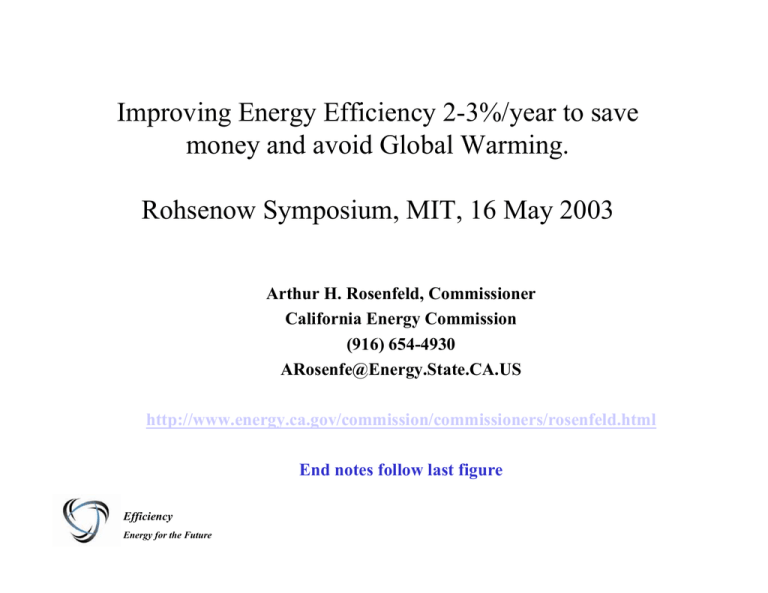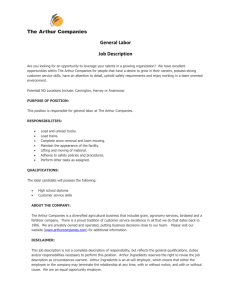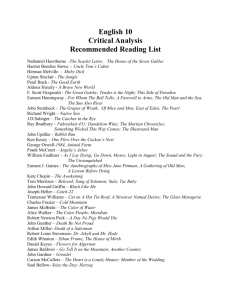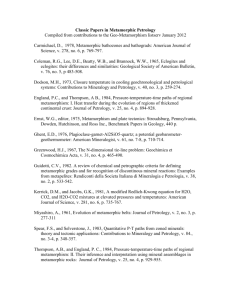Improving Energy Efficiency 2-3%/year to save money and avoid Global Warming.
advertisement

Improving Energy Efficiency 2-3%/year to save money and avoid Global Warming. Rohsenow Symposium, MIT, 16 May 2003 Arthur H. Rosenfeld, Commissioner California Energy Commission (916) 654-4930 ARosenfe@Energy.State.CA.US http://www.energy.ca.gov/commission/commissioners/rosenfeld.html End notes follow last figure Efficiency Energy for the Future California Peak Power Demand:Planned in 1974, and Actual to 1990 Efficiency Energy for the Future Arthur Rosenfeld, Figure 2 California Peak Power Demand: Planned in 1974 Compared to Actual 70 22 GW difference by 1993 Projected Demand + Reserves in California 60 Nuclear 50 Fossil "Actual" Demand + Reserves 5%/yr 1.8%/yr Hydro & Geo 40 30 20 1.7%/yr 10 Efficiency Energy for the Future Arthur Rosenfeld, Figure 3 1999 1997 1995 1993 1991 1989 1987 1985 1983 1981 1979 1977 1975 1973 1971 1969 1967 0 1965 GW, or Population in millions population in million United States Refrigerator Use v. Time 25 1800 1600 1978 Cal Standard Refrigerator Size (cubic feet) 1200 1980 Cal Standard 15 1987 Cal Standard 1000 800 10 600 Energy Use per Unit 1990 Federal Standard 1993 Federal Standard 400 5 2001 Federal Standard 200 19 49 19 51 19 53 19 55 19 57 19 59 19 61 19 63 19 65 19 67 19 69 19 71 19 73 19 75 19 77 19 79 19 81 19 83 19 85 19 87 19 89 19 91 19 93 19 95 19 97 19 99 20 01 0 47 0 Efficiency Energy for the Future Arthur Rosenfeld, Figure 4 Refrigerator volume (cubic feet) 20 1400 19 Average Energy Use per Unit Sold (kWh per year) 2000 United States Refrigerator Use (Actual) and Estimated Household Standby Use v. Time Estimated Standby Power (per house) 1800 1600 1400 Refrigerator Use per Unit 1978 Cal Standard 1200 1987 Cal Standard 1000 1980 Cal Standard 800 1990 Federal Standard 1993 Federal Standard 2009 2007 2005 2003 2001 1999 1997 1989 1987 1985 1983 1981 1979 1977 1975 1973 1971 1969 1967 1965 1963 1961 1959 1957 1955 1953 1951 1949 0 1995 2001 Federal Standard 200 1993 400 1991 600 1947 Average Energy Use per Unit Sold (kWh per year) 2000 Efficiency Energy for the Future Arthur Rosenfeld, Figure 5 Electricity Generating Capacity for 150 Million Refrigerators + Freezers in the US 60 50 GW 40 30 capacity saved capacity needed 20 10 0 at 1974 efficiency at 2001 efficiency Efficiency Energy for the Future Arthur Rosenfeld, Figure 6 Electricity Use of Refrigerators and Freezers in the US compared to Generation from Nuclear, Hydro, Renewables and ANWR 800 Nuclear 700 500 400 150 M Refrig/Freezers 200 100 at 1974 eff Conventional Hydro at 2001 eff Saved Used 300 Used Billion kWh per year 600 50 Million 2 kW PV Systems Existing Renewables 3 Gorges Dam 0 Efficiency Energy for the Future Arthur Rosenfeld, Figure 7 The Value of Energy Saved and Produced (production @ .03 and savings @ .085 $/kWh) 25 Billion $ per year 20 Nuclear Dollars Saved from 150 M Refrig/Freezers at 2001 efficiency 50 Million 2 kW PV Systems 15 Conventional Hydro 10 5 3 Gorges Dam Existing Renewables 0 Efficiency Energy for the Future Arthur Rosenfeld, Figure 8 3 Gorges Dam vs. added Appliances in 2010 3 Gorges: 18 GW x 3,500 hours/year = 63 TWh at wholesale Refrigerators 125 Million Air Conditioning 100 Million Today's Use per unit per year 2003-2010 sales at this efficiency 440 kWh 55 TWh 360 kWh 36 TWh Least Cost Optimum per unit per year 2003-2010 sales at high efficiency Percent Saved 265 kWh 33 TWh 40% 233 kWh 23 TWh 35% 55 TWh Savings from Least Cost Optimum 22 TWh 13 TWh 35 TWh Estimated Sales 2003 - 2010 Total 91 TWh Conclusion: Optimum appliances could save 35 TWh/year, about one-half of 3 Gorges generation in 2010. Savings at retail at least twice as valuable as wholesale, so economically equivalent to the entire 3 Gorges project. Efficiency Energy for the Future Source: David Fridley - LBNL Arthur Rosenfeld, Figure 9 Estimated Power Saved Due to Air Conditioning Standards (1974 - 2002) 1975 Average 1992 Standard 2006 Standard SEER NONE 10 12 COP 2 2.5 3.2 EER 7 9 11 SEER= Seasonal Energy Efficiency Rating COP = Coefficienct of Performance EER = Energy Efficiency Rating, 3.415 x COP So, Standards have avoided (9/7 -1) or 28% of peak and the new 2006 will avoid (11/9 - 1) or 22% of peak GW For a Grand Total Savings of 50% Efficiency Energy for the Future Arthur Rosenfeld, Figure 10 Estimated Power Saved Due to Air Conditioning Standards (1974 - 2002) (cont’d) Peak Power for United States Air Conditioning ~ 250 GW But standards cover only residential and rooftop units ~ 200 GW Avoided GW: 50% of 200 GW = 100 GW Comparisons: – California Peak Load ~ 50 GW – United States Nuclear Plants net capability ~ 100 GW Cooler roofs will save another 10% of 200 GW – Flat roofs, new or replacement, should be white • To be required in 2005 California Building Standards – Sloped roofs, new or replacement, can be colored but cool – Each strategy saves 10%, so 20 GW total Just switching a-c equipment located outside to white should save another 1%, or 2 GW Efficiency Energy for the Future Arthur Rosenfeld, Figure 11 Total Electricity Use, per capita, 1960 - 2001 kWh 14,000 12,000 12,000 U.S. 10,000 8,000 KWh 8,000 7,000 6,000 California 4,000 2,000 2000 1998 1996 1994 1992 1990 1988 1986 1984 1982 1980 1978 1976 1974 1972 1970 1968 1966 1964 1962 1960 0 Efficiency Energy for the Future Arthur Rosenfeld, Figure 12 GWH Impacts from Programs Begun Prior to 2001 40,000 ~ 14% of Annual Use in California in 2001 35,000 30,000 20,000 Utility Programs 15,000 10,000 Building Standards 5,000 Appliance Standards 0 19 75 19 76 19 77 19 78 19 79 19 80 19 81 19 82 19 83 19 84 19 85 19 86 19 87 19 88 19 89 19 90 19 91 19 92 19 93 19 94 19 95 19 96 19 97 19 98 19 99 20 00 GWH 25,000 Efficiency Energy for the Future Source: Mike Messenger, CEC Staff, April 2003 Arthur Rosenfeld, Figure 13 United States Energy Consumption 1949 to 2001 Source: Table 1.5 Annual Energy Review; data for 2001 is preliminary 120 100 60 40 20 01 99 20 97 19 95 19 19 93 91 19 89 19 19 87 85 19 83 19 81 19 19 79 77 19 75 19 19 73 71 19 69 19 67 19 19 65 63 19 61 19 19 59 57 19 55 19 53 19 19 51 19 49 0 19 Quadrillion Btus 80 Efficiency Energy for the Future Arthur Rosenfeld, Figure 14 Energy Consumption Per Person 1949 to 2001 Source: Table 1.5 Annual Energy Review; data for 2001 is preliminary 400 350 300 200 150 100 50 01 99 20 97 19 95 19 19 93 91 19 89 19 19 87 85 19 83 19 81 19 19 79 77 19 75 19 19 73 71 19 69 19 67 19 19 65 63 19 61 19 19 59 57 19 55 19 53 19 19 51 19 49 0 19 Million Btus 250 Efficiency Energy for the Future Arthur Rosenfeld, Figure 15 Energy Consumption Per $ of Gross Domestic Product 1949-2001 Source: Table 1.5 Annual Energy Review; data for 2001 is preliminary 20 15 10 5 01 20 99 97 19 95 19 19 93 19 91 89 19 87 19 19 85 19 83 81 19 79 19 19 77 19 75 73 19 71 19 19 69 19 67 65 19 63 19 19 61 19 59 57 19 55 19 19 53 19 51 19 49 0 19 Thousand Btus per Chained 1992 Dollar 25 Efficiency Energy for the Future Arthur Rosenfeld, Figure 16 Annual Rate of Change in Energy/GDP for the United States IEA (Energy/Purchasing Power Parity) and EIA (Energy/Market Exchange Rate) 2% - 3.4% - 2.7% Average = - 0.7% 1% -1% -2% -3% -4% IEA data EIA data -5% -6% Efficiency Energy for the Future Arthur Rosenfeld, Figure 17 2001 2000 1999 1998 1997 1996 1995 1994 1993 1992 1991 1990 1989 1988 1987 1986 1985 1984 1983 1982 1981 0% Annual Rate of Change in Energy/GDP for Europe IEA (Energy/Purchasing Power Parity) for European Union and Western Europe EIA (Energy/Market Exchange Rate) 2% - 1.2% Average = - 1.3% - 1.4% 1% -1% -2% -3% IEA data EIA data -4% Efficiency Energy for the Future Arthur Rosenfeld, Figure 18 2001 2000 1999 1998 1997 1996 1995 1994 1993 1992 1991 1990 1989 1988 1987 1986 1985 1984 1983 1982 1981 0% Annual Rate of Change in Energy/GDP for China IEA (Energy/Purchasing Power Parity) and EIA (Energy/Market Exchange Rate) 2% Average = - 5.0% - 4.8% - 5.3% -2% -4% -6% IEA data -8% EIA data -10% Efficiency Energy for the Future Arthur Rosenfeld, Figure 19 2001 2000 1999 1998 1997 1996 1995 1994 1993 1992 1991 1990 1989 1988 1987 1986 1985 1984 1983 1982 1981 0% Annual Rate of Change in Energy/GDP for the World IEA (Energy/Purchasing Power Parity) and EIA (Energy/Market Exchange Rate) 2% - 1.3% Average = - 0.7% - 1.3% 1% 2001 2000 1999 1998 1997 1996 1995 1994 1993 1992 1991 1990 1989 1988 1987 1986 1985 1984 1983 1982 1981 0% -1% -2% -3% IEA data EIA data note: Russia not included until 1992 in IEA data and 1993 in EIA data -4% Efficiency Energy for the Future Arthur Rosenfeld, Figure 20 Green House Gas Intensity (GHG/GDP indexed, 2000=1) 1.5 1.4 1.3 1.2 Administration Goal in 2012 1.1 1 21 year trend (1980 - 2001) 0.9 -0.019x 0.8 y = 3E+16e Recent trend (1997 - 2001) 0.7 2 R = 0.9625 -0.0285x y = 6E+24e 0.6 2 R = 0.9799 0.5 0.4 0.3 0.2 0.1 2045 2040 2035 2030 2025 2020 2015 2010 2005 2000 1995 1990 1985 1980 0 1975 Green House Gas Emissions per Unit GDP (indexed, 2000=1) 1.6 Efficiency Energy for the Future Arthur Rosenfeld, Figure 21 The “Conservation Bomb” Quads/yr (World Primary Power or Energy) TWa 50 1500 10 billion people @ 5 kW = 50 TW α = 0%/yr 1200 40 α = Annual % growth in Energy/GDP 900 30 α= 20 α= 6 billion people @ 2 kW = 12 TW 10 α= -1% /yr 600 -2% /yr 300 -3% /yr 0 0 2000 Efficiency Energy for the Future 2100 Year Arthur Rosenfeld, Figure 22 Efficiency Energy for the Future Arthur Rosenfeld, Figure 23 Efficiency Energy for the Future Arthur Rosenfeld, Figure 24 Arthur H. Rosenfeld, Commissioner, California Energy Commission (916)654 4930; Cell phone (916)205-3965; Arosenfe@energy.state.ca.us Energy Policy should plan to drop Energy Intensity (E/GDP) 2-3%/year; we’re doing that now in the West and in China, and if we keep it up we can prevent serious global warming. Figure 1 – Title and presenter page Figure 2. This figure dates back to 1975. (Source: Annual Review of Energy and the Environment, Volume 24, 1999, page 41). Before the OPEC embargo, Calif. Power demand was growing 6%/year, and population was growing at 1.5%/year, so per capita power was growing about 4.5%/year. Now, per capita, it is flat, so we’ve shaved > 4%/year, always with a simple payback time (SPT) < 5 years. In energy policy, many developing countries today are where the West was in 1974, so they can achieve similar remarkable savings. Figure 3. Provides updates to Figure 2. Actual demand growth over the last twelve years has been at a rate of 1.8% per year. California’s population has risen at 1.7% per year. The bar labelled Nuclear, Fossil, Hydro&Geo shows nuclear and fossil plants planned in 1975 but later cancelled. Figure 4. The most effective path toward energy efficiency has been standards for autos, buildings, appliances, equipment, etc. Figure 4 shows the remarkable gains in refrigerators. The red smoothly rising line is the increase in size, and the unit energy use is not corrected for this, nor the fact that we’ve dropped CFC’s. Since 1975, refrigeration labels and standards have improved efficiency 5%/year for 25 straight years. We have now saved 40 GW of power plants, just due from refrigerators. Figure 5. Shows the estimated growth of “standby” power, compared to refrigerators. Standby power is still unregulated, and is already 5-10% of world residential kWh use. This shows the need for vigilance and an aggressive standards program Figure 6 shows the savings from improved US refrigerators and freezers (40 GW) Figure 7 is the same gain, expressed in TWh/year, compared with all US hydro, the Three Gorges dam, existing renewables, and nuclear power. Figure 8 is Figure 7, re-expressed in dollars, noting that refrigerators save retail electric cost, whereas a kWh of supply is worth only its wholesale price, and in the United States the retail/wholesale ratio is nearly three to one. So, expressed in dollars, refrigerator bill savings, at the meter, will soon surpass the value of nuclear power, at the bus bar. Figure 9 is based on the analysis that if Chinese refrigerators and air conditioning were as efficient as those in the US, they would use 40% less kWh, and a/c would use 35% less. At today’s rate of Chinese sales, demand from these two appliances will grow to 1.5 times the output of the Three Gorges dam in the decade it will take to fill the dam. If China tightened appliance standards, it could save half the output of the dam. This policy message applies to most developing countries. Figure 10. Air Conditioning Standards have significantly improved the performance of residential and package commercial (“rooftop”) units. To date, we estimate that moving from energy efficiency ratings (EER) of 7 to 9 have saved 28% of the United States peak load and the new 2006 standards (EER = 11) will save an additional 22%. 1/3 Figure 11 continues the discussion of estimated power savings due to air conditioning. By moving from EER 7 to 11, we will avoid the need for 100 GW of peak generating capability. This is about twice the California peak load and about equal to the nuclear capacity in the United States. In addition, cool roofs can save an additional 20 GW. Figure 12 compares kWh/capita for California, constant for 27 years, with the US, which during the same time grew 50%, i.e. 2%/year. Figure 13 shows an estimate of the causes of this 2%/year gain. Each year, the cost of conservation programs, public interest R&D, and standards adds ~1% to electric bills, but cuts 1/2% off the bill. So an investment of $1 in say 1990 saves $.50 per year for 10 to 20 years. Although not depicted on this slide, other policies also have led to electricity savings in California. For example, California standards allow electric water heating in homes only when it is cost effective: which is seldom the case. This has resulted in only limited electricity use for this purpose in California. Per Capita use is just 200 kWh in California for electric hot water heating while in Florida the use is about 1,200 kWh per person. Figures 14, 15, and 16 show US primary energy (not electricity) use from 1949 to present, for the United States, per capita, and per $ of real GDP. Note the downward kink in E/GDP (see Figure 16) starting in 1997 Figures 17 through 20 illustrate annual rates of change in energy intensity data provided by the United States Energy Information Agency and the International Energy Agency. Figures are provided for the United States, Western Europe, China and the entire World. Recent changes (from 1997 onward) look to me (and to Joe Romm) to be making a permanent change in the rate of decrease of our energy intensity (E/GDP). The vertical lines divide the time period (1981 to 2001) into three eras. Era 1 covers the latter years of high OPEC oil prices. Era 2 starts soon after the collapse of OPEC and the consequent stagnation of CAFE (Corporate Automobile Fuel Economy) standards. Era 3 begins with the significant impact of information technologies on business and the economy. The numbers written above each era reflect the average rate of change in E/GDP (EIA data) for that era. Compare for example, in Figure 17 the United States trend in Era 2 of only – 0.7% per year to the more sudden – 2.7% per year in Era 3. Figure 18 shows a nearly constant improvement in E/GDP, averaging – 1.3% over the entire time period. Also of note, see Figure 19, are the efficiency gains made by China. Over the last twenty years China has averaged - 5% per year in E/GDP. Figure 21 shows GHG (GreenHouse Gas) intensity (i.e. per GDP) for the last 26 years. The Blue 21-year fit, which is also the Bush Admin. Target, drops 1.9%/year, BUT the red 5-year fit drops 2.85%/year, and gets us down to 50% 10 years earlier. I think the Administration goal should at least try to keep up the 5-year trend. Figure 22 illustrates the 100 year importance of maintaining the 2-3%/year drop in energy intensity, compared to 1%, and is stimulated by Hoffert (Martin Hoffert (NYU) et al., Nature 395, 29 Oct. 1998, p. 881; www.nature.com), whose 1998 paper in Nature says that 1%/year is as good as we can hope for. Hoffert et al. then call for a Manhattan-scale project for getting off fossil fuel. My cheaper and faster approach is to invest more heavily in negawatts. In Figure 22, the vertical scale is world energy use, in TWa (“a” for average) on the left, or Quads/yr on the right. The blue bar (12 TWa) at 2000 represents today’s energy use. Now I chose a goal for 2100, mainly for the developing world outside of US, Europe, and Japan. Population is leveling 2/3 off, thankfully, so 10 billion people in 2100 seems generous. Let’s plan to give everybody the standard of living, and the energy use/capita, of W. Europe today (i.e. 5 kWa, compared with 2 kWa worldwide). Then world TWa would be 10B x 5 kWa = 50 TWa, or about 4 times today. We plot this as the red bar at 2000, since it’s just 10 B x today’s technology). But we have 100 years before we are there. So we introduce Alpha as the rate of growth of energy intensity. If Hoffert’s right and alpha = -1%/year, then we’ll drop from 50 to 18 TW (i.e. drop to only 1.5 x today). But if we can keep up even 2%/year, then in 100 years we’ll be down to half of today, and with alpha = -3% ---- no GHG problem. Of course, even with alpha = -2%, the energy trajectory during this century will still grow before it levels off. And the West may have become very energy intensive; but we’re so rich we really can develop wind and other promising renewables. But I hope I’ve shown the importance of keeping our eye on the greenest energy of all --- negawatts through vigilant efficiency improvement. Figure 23 shows direct lights, visible from an airplane above Los Angeles. During the 20002001 California electricity crisis, the CEC was given the power to regulate out-door lighting, and thus reduce CA kWh usage by 1-2%. Thus modern street lights, instead of drawing say 150 watts with half the light going upwards, will need only 75watt if a reflector directs all the light downward. So seen from the air at night, California cities should gradually disappear. This slide illustrates how we can add new scope to our energy efficiency standards and policies. Figure 24 shows how Bermuda homes avoid air conditioning with white roofs. The California 2005 new building standards will give credit for cool roofs. Eventually this will save several percent of our peak power demand. This is another example of adding new scope to our efficiency portfolio. If we keep addressing new areas (like outdoor lighting or cool roofs) each year, and improving vehicles, buildings, equipment, and industrial and agricultural processes, we should be able to keep alpha at –2% to –3% per year, thus saving money and capping global warming. 3/3






